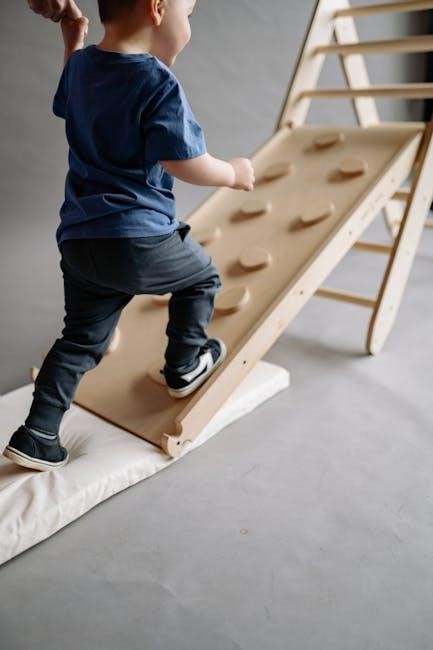Manual retraction of a slide out is necessary when the motor fails‚ using a hand pump or drill to retract the slide‚ following specific procedures to avoid damage‚ with caution always.
Understanding the Basics of Slide-Out Mechanisms
Slide-out mechanisms are designed to provide additional space and comfort in recreational vehicles‚ and understanding how they work is crucial for manual retraction. The mechanisms typically consist of a motor‚ gear system‚ and slide-out frame‚ which work together to extend and retract the slide-out. There are different types of slide-out mechanisms‚ including hydraulic‚ rack and pinion‚ and cable systems‚ each with its own unique characteristics and requirements. The motor plays a key role in the slide-out mechanism‚ as it provides the power needed to extend and retract the slide-out. When the motor fails‚ manual retraction is necessary‚ and understanding the basics of the slide-out mechanism is essential for this process. By knowing how the mechanism works‚ individuals can better troubleshoot issues and perform manual retraction safely and effectively‚ using tools such as hand pumps or drills to retract the slide-out. This knowledge is vital for successful manual retraction.

Preparation for Manual Retraction
Prepare for manual retraction by gathering tools and information‚ ensuring safety always.
Checking Battery Voltage and Identifying the Slide
To begin the process of manual retraction‚ it is essential to check the battery voltage and identify the slide that needs to be retracted. This involves locating the battery and using a voltage meter to ensure that it has a good 12 volts. The slide should also be identified‚ taking note of its type and location. This information is crucial in determining the best approach for manual retraction. The process of checking the battery voltage and identifying the slide is a critical step that should not be overlooked. It is necessary to have a good understanding of the electrical system and the slide mechanism to proceed with the manual retraction process. By following these steps‚ you can ensure a safe and successful manual retraction of the slide out. The correct identification of the slide and battery voltage is vital for a smooth operation.

Manual Retraction Methods
Manual retraction methods involve using tools like hand pumps or drills to retract slides‚ requiring careful technique and attention to detail always and every time perfectly.
Retracting Hydraulic Slides Using a Hand Pump
To retract hydraulic slides using a hand pump‚ locate the motor and hand pump‚ then use a bar to manually pump the motor‚ opening or closing the slide-out. This process requires careful attention to detail and technique. The hand pump is typically connected to the hydraulic system‚ allowing manual control over the slide-out’s movement. It is essential to follow the manufacturer’s instructions for manual retraction to avoid damage to the system. By using a hand pump‚ you can retract the slide-out in the event of a motor failure‚ ensuring your safety and convenience. The process may vary depending on the specific hydraulic slide-out system‚ so it is crucial to consult the user manual or contact a professional if unsure. Proper use of the hand pump will help maintain the slide-out’s functionality and longevity. Regular maintenance is also necessary.
Retracting Cable RV Slide Outs with a Drill
Retracting cable RV slide outs with a drill is a method used when the motor fails‚ allowing manual retraction of the slide-out. This process involves checking the battery voltage and ensuring a good 12 volts from the battery or charging system. A drill can be used to manually turn the motor‚ retracting the slide-out. It is essential to follow the correct procedure to avoid damage to the system. The drill must be connected to the motor‚ and the slide-out must be secured for transport. Regular maintenance of the cable RV slide out system is necessary to prevent failures. By using a drill‚ you can manually retract the slide-out‚ ensuring your safety and convenience. The process requires careful attention to detail and technique‚ and it is crucial to consult the user manual or contact a professional if unsure. Proper use of the drill will help maintain the slide-out’s functionality and longevity‚ and it is a useful skill to have.

Troubleshooting and Safety Precautions
Always follow safety guidelines and precautions when manually retracting‚ ensuring personal safety and preventing damage to the slide-out system and surrounding structures always and carefully.
Releasing the Brake on the Motor and Avoiding Overcranking
To manually retract a slide out‚ it is crucial to release the brake on the motor‚ which can be done by following the manufacturer’s instructions or consulting the user manual. This step is essential to prevent damage to the motor and the slide-out system. When releasing the brake‚ care should be taken to avoid overcranking‚ which can cause damage to the system and lead to costly repairs. The manual override crank tool should be connected to the extension rod‚ and the crank handle should be turned clockwise to retract the slide-out. It is essential to stop when resistance is felt and the slide is flush with the exterior RV wall‚ as overcranking can damage the slide-out. By following these steps and taking necessary precautions‚ the brake on the motor can be released‚ and the slide-out can be manually retracted safely and efficiently‚ always following safety guidelines.

Specific Retraction Procedures for Different Slide Types
Manual retraction procedures vary depending on slide type‚ requiring specific tools and techniques always.
Retracting Rack and Pinion Slides and In-Wall Slides
Retracting rack and pinion slides and in-wall slides requires careful consideration of the specific mechanisms involved. For rack and pinion slides‚ a manual override crank tool may be necessary to retract the slide. In-wall slides‚ also known as Schwintek slides‚ have a unique mechanism that requires a different approach. The motor must be removed and the slide retracted manually‚ using a specific procedure to avoid damage. It is essential to consult the manufacturer’s instructions for the specific slide type being retracted. Additionally‚ it is crucial to take necessary safety precautions to avoid injury or damage to the slide or surrounding structures. By following the correct procedure and taking necessary precautions‚ it is possible to successfully retract rack and pinion slides and in-wall slides manually. This process can be complex‚ but with the right guidance‚ it can be accomplished safely and effectively.
Manually Retracting Above Floor Mount RV Slide Outs
Above floor mount RV slide outs have a distinct mechanism that requires a specific manual retraction process. To begin‚ identify the slide type and locate the motor and hand pump. Next‚ release the brake on the motor and use a bar to manually pump the motor‚ retracting the slide. It is essential to secure the slide in place once retracted to ensure safe transport. The process involves several steps‚ including checking battery voltage and ensuring a good 12 volts from the battery or charging system. By following the correct procedure‚ above floor mount RV slide outs can be manually retracted safely and effectively‚ avoiding potential damage to the slide or surrounding structures. This process requires patience and attention to detail‚ but with the right guidance‚ it can be accomplished successfully‚ getting the slide in manually and securing it for transport. Manual retraction is a valuable skill for RV owners to possess.